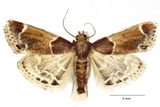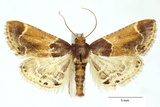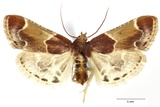Pyralis farinalis Linnaeus, 1758 Species
Last modified: Nov. 21, 2025, 3:47 p.m.
A common species throughout Belgium, well distributed in the northern part.
Details
- Classification
- Family: Pyralidae > Subfamily: Pyralinae > Tribus: Pyralini > Genus: Pyralis > Species: Pyralis farinalis
- Vernacular names
- Grote meelmot (NL), Meal moth (EN), la Pyrale de la farine (FR), Mehlzünsler (DE)
- First mention in Belgium
- De Sélys-Longchamps E. 1844. Énumération des insectes Lépidoptères de la Belgique. — Mémoires de la Société royale des Sciences de Liége 2: 1–35. On page 19 (as Pyralis farinalis Wv.). view page
- Status
-
Native
Distribution
Egg
The adult female lays about 200 – 400 eggs laid in piles of grain or accumulations of plants. They hatches after a few days.
Caterpillar
The larval stage takes as little as 6 weeks. It is cream-colored and hairless.
Bionomics
The larvae spin tough silk tubes or gallery that are coated or mixed with food particles, firmly attached to a structure. They stay in these tubes and feed from the open ends. When fully developed, the larvae leave these tubes and spin silken cocoons in which they pupate.
They rest characteristically with the tip of the abdomen curved up at right-angles to the body. The adults are active at night and comes occasionally to light and sugar. Rarely seen outside his preferred habitat such as warehouses and other grainstores.
Flight periods
They are observed practically all year round, especially indoors. Main flightperiod from May till October.
Observed on
- Substrates:
- Stored products (grain, rice, nuts, etc.)
The phytophagous larvae live on stored products like stored grain, flour, corn meal and other milled grain products, household foodstuffs and dead or wilted plant material.
Habitat
It inhabits homes, bakeries, silos, haystacks, grain stores, barns etc...




